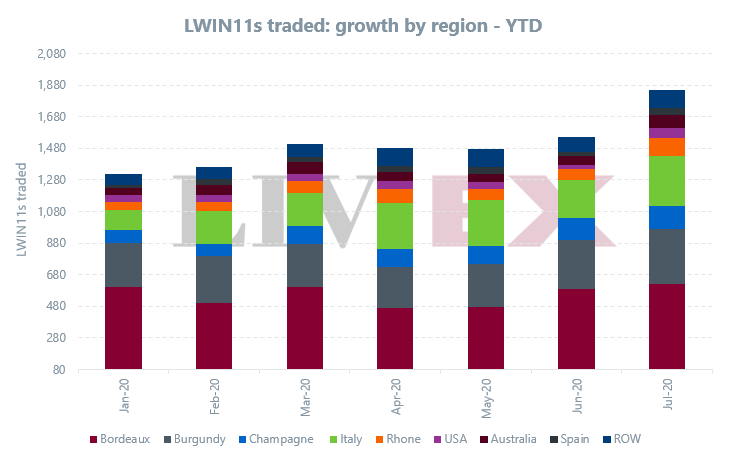As part of our series analysing the fine wine market in the first half of the year (best performing wines, most searched for wines by merchant location, most traded wines & shape of the market), today’s post takes a look at the number of unique wines trading on Liv-ex, as measured by LWIN*.
The number of unique wines traded in the first half of 2020 grew 37% over the equivalent period in 2019. The second half of the year started even stronger, in July the amount of wines traded (LWIN7) broke past 1,000 for the first time in Liv-ex’s history and expanded on the previous highest month by over 20%, seen below.
In January, Bordeaux held majority of the unique wines traded, 46%. However, as the year progressed, Bordeaux relinquished a portion of that share, falling to 34% in July. Bordeaux, Burgundy, Italy and Champagne accounted for 83% of the total trades in January – that figure fell to 77% in July.

Across the seven months, Bordeaux posted the smallest growth in wines traded while Italy, Spain and the Rhone increased the most – up 154%, 153% and 127%, respectively, from their January levels.
Italy has had the added benefit of being excluded from the 25% US wine tariffs and with the addition of the much-heralded Brunello 2015s and Barolo 2016s, unique wines traded grew to record levels.
Interestingly, Spain, although small in comparison, has grown to match the unique wines traded from the US.
Burgundy continues to secure approximately 20% of LWINs traded per month, showing consistent growth with the overall market.
Wines traded from the Rest of the World (ROW) has had significant growth as Austria, Germany, Chile and the Loire all added unique wines to mix.
*LWIN is the universal identifier for wine and spirits. It is a lot like ISBN for books, in that each wine (or spirit) has a unique numerical code which can be used to standardise detailed product information.
LWINs are unique 7, 11, 16 or 18-digit codes. The 7-digit code refers to the wine itself (i.e. the producer and brand, grape or vineyard). The longer codes include information about the vintage, bottle and pack size.
For more information on LWIN, click here.





